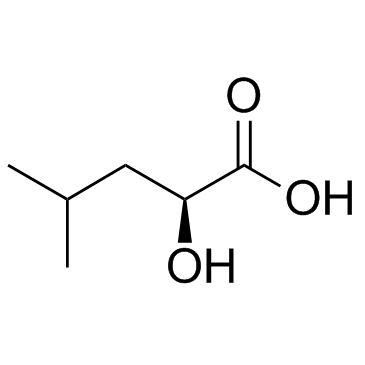L-Leucic acid

L-Leucic acid structure
|
Common Name | L-Leucic acid | ||
|---|---|---|---|---|
| CAS Number | 13748-90-8 | Molecular Weight | 132.158 | |
| Density | 1.1±0.1 g/cm3 | Boiling Point | 251.3±13.0 °C at 760 mmHg | |
| Molecular Formula | C6H12O3 | Melting Point | 78-80ºC(lit.) | |
| MSDS | Chinese USA | Flash Point | 120.1±16.3 °C | |
|
Renal clearance of branched-chain L-amino and 2-oxo acids in maple syrup urine disease.
J. Inherit. Metab. Dis. 22(6) , 706-22, (1999) In maple syrup urine disease (MSUD), branched-chain L-amino (BCAA) and 2-oxo acids (BCOA) accumulate in body fluids owing to an inherited deficiency of branched-chain 2-oxo acid dehydrogenase complex activity. In MSUD, little information is available on the s... |
|
|
Rapid diagnosis of phenylketonuria and other aminoacidemias by quantitative analysis of amino acids in neonatal blood spots by gas chromatography-mass spectrometry.
J. Chromatogr. B. Analyt. Technol. Biomed. Life Sci. 775(1) , 115-20, (2002) A new method for quantifying specific amino acids in small volumes of plasma and whole blood has been developed. Volatile derivatives of amino acids are analyzed by gas chromatography-mass spectrometry. The method only takes a few minutes to perform and requi... |
|
|
Hydroxy acid metabolites of branched-chain amino acids in amniotic fluid.
Clin. Chim. Acta 140(2) , 157-66, (1984) A method is described in which ammonia chemical ionization gas chromatography-mass spectrometry was utilized in the selected ion monitoring mode to provide an accurate, selective approach to the quantification in amniotic fluid of a number of hydroxylated org... |
|
|
Comparative utilization of the alpha-keto and D- and L-alpha-hydroxy analogs of leucine, isoleucine and valine by chicks and rats.
J. Nutr. 112(10) , 1929-39, (1982) Several experiments were conducted to quantitatively evaluate the growth-promoting capacity of the isomers of the branched-chain amino acids (BCAA) and their alpha-hydroxy and alpha-keto analogs for the chick and rat. Basal chemically defined diets were formu... |
|
|
Studies of urinary organic acid profiles of a patient with dihydrolipoyl dehydrogenase deficiency.
Clin. Chim. Acta 133(2) , 133-40, (1983) Using gas chromatography-mass spectrometry (GC/MS), urinary organic acid profile studies were carried out on a patient with dihydrolipoyl dehydrogenase (E3) deficiency. Elevated levels of 2-hydroxyglutaric acid, 2-hydroxyisocaproic acid and 2-oxoisocaproic ac... |
|
|
[The growth of rats in renal compensatory adaptation in feeding with a supplemented diet of hydroxy-analogs of essential amino acids].
Z. Urol. Nephrol. 82(2) , 105-12, (1989) Rats were fed protein-restricted after unilateral nephrectomy (6.7% casein). Comparatively other animals were fed with experimental diets, at which 20% of the casein have been replaced by Ketosteril or a mixture of hydroxy acid. The constituents of this mixtu... |
|
|
NMR spectroscopic detection of chirality and enantiopurity in referenced systems without formation of diastereomers.
Nat. Commun. 4 , 2188, (2013) Enantiomeric excess of chiral compounds is a key parameter that determines their activity or therapeutic action. The current paradigm for rapid measurement of enantiomeric excess using NMR is based on the formation of diastereomeric complexes between the chir... |
|
|
Effects of alfa-hydroxy-isocaproic acid on body composition, DOMS and performance in athletes.
J. Int. Soc. Sports Nutr. 7 , 1, (2010) Alfa-Hydroxy-isocaproic acid (HICA) is an end product of leucine metabolism in human tissues such as muscle and connective tissue. According to the clinical and experimental studies, HICA can be considered as an anti-catabolic substance. The present study inv... |
|
|
Bioactivation mechanism of L-thiomorpholine-3-carboxylic acid.
Arch. Biochem. Biophys. 273(2) , 562-71, (1989) L-Thiomorpholine-3-carboxylic acid (L-TMC) is a cyclized analog of S-(2-chloroethyl)-L-cysteine, which is cytotoxic in vitro and nephrotoxic in vivo. To determine whether L-TMC may play a role in S-(2-chloroethyl)-L-cysteine-induced toxicity, the cytotoxicity... |
|
|
2-Hydroxyisocaproic acid (HICA): a new potential topical antibacterial agent.
Int. J. Antimicrob. Agents 39(6) , 539-40, (2012)
|